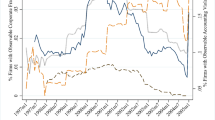Abstract
Under the efficient market hypothesis, the stock price incorporates the full value of a firm’s advertising. If so, advertising spending should not be associated with future abnormal stock returns. Nevertheless, from 1995 to 2015, advertising spending often leads to abnormal stock returns the following year. The strongest results surface for consumer goods and services where advertising used to build brand equity can carryover from one year to the next. No significant differences arise for healthcare, industrial goods, or retailer advertising. Healthcare and industrial goods advertising is often modest. Retailer advertising that builds traffic should have little if any carryover into the following year. These results may help marketing managers defend an advertising budget whose benefits carryover into the following year, but hurt current profits. Having more investment analysts on Wall Street with a marketing background should help reduce this overly conservative “wait and see” discount for carryover advertising.
Similar content being viewed by others
Notes
Prior studies in the finance and accounting literature often exclude regulated utility firms (SIC 4900–4999) and financial institution (SIC 6000–6999). Financial firms are excluded because their high leverage does not have the same meaning as for nonfinancial firms, where high leverage often indicates distress.
While some firms in the services group provide business services, the majority provide consumer services.
See Fama and French (2015) for a complete description of the SMB and HML factor returns.
References
Carhart, M. (1997). On persistence in mutual fund performance. Journal of Finance, 52(1), 57–82.
Chan, L. K. C., Lakonishok, J., & Sougiannis, T. (2001). The stock market valuation of research and development expenditures. Journal of Finance, 56, 2431–2456.
Chen, C., Chiang, M., & Yang, C. (2014). New product preannouncements, advertising investments, and stock returns. Marketing Letters, 25, 207–218.
Eberhart, A. C., Maxwell, W. F., & Siddique, A. R. (2004). An examination of long-term abnormal stock returns and operating performance following R&D increases. Journal of Finance, 59(2), 623–650.
Fama, E., & French, K. R. (2015). A five-factor asset pricing model. Journal of Financial Economics, 116, 1–22.
Jacobson, R., & Mizik, N. (2009). The financial markets and customer satisfaction: reexamining possible financial market mispricing of customer satisfaction. Marketing Science, 28(5), 810–819.
Jedidi, K., Mela, C. F., & Gupta, S. (1999). Managing advertising and promotion for long-run profitability. Marketing Science, 18 , 1–22.Winter
Joshi, A. M., & Hanssens, D. M. (2010). The direct and indirect effects of advertising spending on firm value. Journal of Marketing, 74, 20–33.
Kim, M. C., & McAlister, L. M. (2011). Stock market reactions to unexpected growth in marketing expenditure: negative for sales force, contingent on spending level for advertising. Journal of Marketing, 75, 68–85.
Kotler, P., & Keller, K. L. (2006). Marketing Management. Upper Saddle River, NJ: Pearson Prentice-Hall.
Leone, R. P. (2009). “Advertising impact duration,” in Empirical Generalizations About Marketing Impact, Dominique M. Hanssens, ed. Cambridge, Marketing Science Institute, 89.
Lodish, L. M., Abraham, M. M., Livelsberger, J., Lubetkin, B., Richardson, B., & Stevens, M. E. (1995). A summary of fifty-five in-market experimental estimates of the long-term effects of TV advertising. Marketing Science, 14(3), G133–G140.
Mizik, N., & Jacobson, R. (2007). Myopic marketing management: evidence of the phenomenon and its long-term performance consequences in the SEO context. Marketing Science, 26(3), 361–379.
Sethuramanm, R., Tellis, G. J., & Briesch, R. A. (2011). How well does advertising work? Generalizations from a meta-analysis of brand advertising elasticities. Journal of Marketing Research, 48(3), 457–471.
Simpson, A. V. (2008). Voluntary disclosure of advertising expenditures. Journal of Accounting, Auditing and Finance, 23(3), 404–436.
Singal, V. (2006). Beyond the random walk: a guide to stock market anomalies and low-risk investing. Oxford: Oxford University Press.
Sorescu, A., Shankar, V., & Kushwaha, T. (2007). New product preannouncements and shareholder value: don’t make promises you can’t keep. Journal of Marketing Research, XLIV, 468–489.
Srinivasan, S., Pauwels, K., Silva-Risso, J., & Hanssens, D. M. (2009). Product innovations, advertising and stock returns. Journal of Marketing, 73, 24–43.
Srinivasan, R., Lilien, G. L., & Sridhar, S. (2011). Should firms spend more on research and development and advertising during recessions? Journal of Marketing, 75, 49–65.
Wall Street Journal (2009). “U.S. ad spending fell 14 % in first quarter,” (June 11), B.7.
Zacks, L. (2011). The handbook of equity market anomalies: translating market inefficiencies into effective investment strategies. Hoboken, NJ: Wiley.
Author information
Authors and Affiliations
Corresponding author
Rights and permissions
About this article
Cite this article
Oh, Y.K., Gulen, H., Kim, JM. et al. Do stock prices undervalue investments in advertising?. Mark Lett 27, 611–626 (2016). https://doi.org/10.1007/s11002-016-9411-4
Published:
Issue Date:
DOI: https://doi.org/10.1007/s11002-016-9411-4




